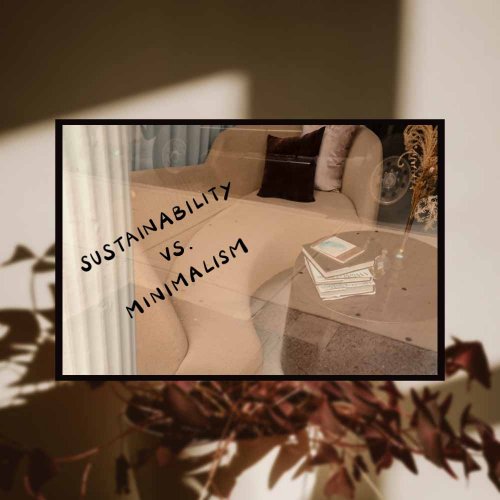この記事は日本語でも読めます。メニューにある Switch to JP ボタンを押してください。
This article is also available in Japanese. Please hit the Switch to JP button in the menu.
Sustainability and minimalism. If you are interested in one, it is likely that you have encountered the other. A minimalist can act sustainably, and vice versa, but they are not the same thing.
I’ve been trying to live a conscious, sustainable lifestyle for the past two years, but I personally wouldn’t call myself a minimalist. While I find a lot of great tips from the minimalist lifestyle, I believe sustainability and minimalism are ultimately not compatible. I consider them to be similar but different. This is something I’ve wanted to talk about for a while – although sustainability and minimalism don’t oppose each other, they can conflict with each other.
The Ideas Behind Sustainability and Minimalism
Sustainability
I found a good perspective on sustainability at the website of GRI (Global Reporting Initiative), a non-profit organization based in the Netherlands who initiated globally-standardized sustainability reporting. The organization points out that sustainability is built on “a thriving global community that lifts humanity and enhances the resources on which all life depends.” The organization’s aim is to tackle issues surrounding sustainability, including “climate change, human rights, governance and social well-being” and to “empower decisions that create social, environmental and economic benefits for everyone.”
Reference: “Mission and Vision” (GRI)
Minimalism
One of the most popular minimalist influencers, The Minimalists (they are actually a duo), define minimalism as follows: “Minimalism is a tool that can assist you in finding freedom. Freedom from fear. Freedom from worry. Freedom from [being] overwhelm[ed]. Freedom from guilt. Freedom from depression. Freedom from the trappings of the consumer culture we’ve built our lives around. Real freedom.” They state that the idea of minimalism is a way to pursue each individual’s happiness by saying “Minimalists search for happiness not through things, but through life itself.”
Reference: “What is Minimalism?” (The Minimalists)
After reading these quotes, it is now crystal clear to me why I found sustainability and minimalism to be similar but different. The motivations behind them are coming from completely different places. Sustainability is concerned with the environment, society, communities, and people, whereas minimalism is largely for one’s own happiness. I’m not here to discuss which concept is better than the other, but as someone who focuses on sustainability, I would like to better understand both ideas in order to avoid mixing them up.
How Do They Actually Differ?
I would like to look at how both lifestyles differ by comparing how each handles the wardrobe and the kitchen.
Wardrobe
Both lifestyles have similar views in regard to the concept of numbers. “Buy less,” “Be conscious when you make a purchase,” etc., are all slogans that can be seen in both worlds.
But if you look more closely, sustainable fashion focuses on how to reduce the number of purchases that are socially or ethically questionable, as well as how to downsize the scale of your environmental impact. On the other hand, minimalist fashion simply emphasizes reducing the numbers of items that you own.
A sustainable wardrobe is not necessarily compact. Sustainable fashion advocates will mend and maintain items to make them last longer, while also adding to their wardrobe in a conscious way. Minimalist fashionistas tend to possess a truly minimal selection of clothes, often employing the Konmari method to shrink the number of items in their closet, leading to a lot of garments being tossed or donated. (I should say Konmari method can be sustainable depending on how things are disposed of.)
How both adherents purchase clothing is different, too. With thorough research, buying sustainable fashion can be an investment in eco-friendly, ethical brands. It can also consist of thrifting, swapping, and giving and receiving hand-me-downs, all of which connect to the idea of #oootd (old outfit of the day.) On the contrary, while minimalist fashion can be high quality, that doesn’t necessarily mean it’s consciously made. I’ve heard there is a minimalist fashion concept that focuses on item circulation, where capsule collections are revamped with new garments regularly, but as mentioned before, the items that don’t stay in circulation are simply discarded and not given a second life.
Kitchen
For the kitchen, I have pulled popular posts from Instagram to visually compare the two, apples to apples.

The left side is #sustainablekitchen, and the right is #minimalkitchen. Though a hashtag is just a hashtag, and how it’s applied depends on the person using it, I still believe there are some telling traits in these pictures.
Sustainable kitchens are (slightly) messier. I featured highly-ranked posts, so while they undoubtedly have an attractive aesthetic, at the same time there is a bunch of clutter in the photos. For example, if you shop package free, there are containers and jars of different sizes and types, which are washed and reused. To avoid mass produced food that tends to be made unethically and loaded with chemicals, you need to use multiple ingredients and tools. To make the most out of your produce, you revitalize veggies in a container filled with water. The goal of a sustainable kitchen is not to own more, but there are reasons why you tend to have more when living sustainably.
A minimalist kitchen, on the other hand, is perfectly neat and clean. There are few items on the counter. Storage is smartly utilized so there’s no clutter. Ultimately, these images illustrate a lifestyle of simplicity and comfort. That being said, a minimalist is not necessarily focused on environmental impact. For instance, to own less, they might prefer disposable options. When focusing on simplicity as style, social responsibility and ethics are not the main factor when choosing products. (And speaking of the kitchen, I find there to be a growing number of vegans/vegetarians in the sustainable-living community as compared to the minimalist community, which indicates the difference between the two, but that is another topic…!)
What Sustainability Can Learn from Minimalism
Since sustainability has become the core of my lifestyle, I have grown more careful and conscious when I make purchases. The me I am today owns less now compared to the me before becoming sustainably minded.
I have never been a minimalist, but I still have learned from that lifestyle. Although I don’t throw away things that I have obtained, I constantly evaluate what I do own and handle what I don’t want in a responsible way. Like a minimalist, I keep my eye open for things that don’t “spark joy”, but I try to find somebody who would want them, instead of trashing or donating them. (Donating items to charity could be a tricky topic because we don’t really know where they end up. However, if you want to use your unwanted items to do good, resale apps or garage/yard/stoop sales can bring in money that can be donated to charities.)
If minimalism is the countercultural response to mass production and mass consumption, then yes, sustainability has a lot of areas that overlap with minimalism. There’s also a huge emphasis among the two to reduce excess and reject the idea that owning stuff equals happiness. However, we also need to acknowledge that sustainability and minimalism are different. Minimalism aims to obtain a satisfying and stress-free lifestyle by reducing and throwing things away in manners that are not always sustainable. A sustainable lifestyle seeks to behave in a socially responsible way, with an eye toward making a positive impact on the world and society, as well as our own lives.
To be mindful of our limited resources on the Earth, and learning to live with what we already have – that is how we can apply the ethos of minimalism in our efforts to live sustainably.
この記事は日本語でも読めます。メニューにある Switch to JP ボタンを押してください。
This article is also available in Japanese. Please hit the Switch to JP button in the menu.




